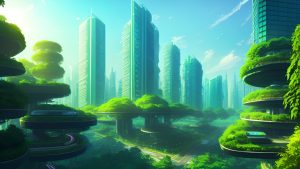When I was a child I remember seeing a magazine about technology with predictions of the future. In it was a graphic novel style panel of images that imaged a future in which we both live in harmony with nature but also had technology, but of a revolutionary kind. The key idea was that we could genetically engineer trees to become living homes for people. So that they would have cavities inside them in which we could live. A kind of magical technology for living within nature. This is similar to something the Indians have done for centuries: trained vines in such a way as to form bridges over rivers.
These ideas of living more in harmony with nature and developing our technologies in a different direction from our current mass production and oil-based system have become more developed in the Solarpunk movement.
What is solarpunk?
Solarpunk is a cultural, social, and aesthetic movement that envisions a future where humanity lives in harmony with nature and relies on renewable energy sources like solar power. It emerged as a sub-genre of science fiction and speculative fiction, as well as a broader artistic and design movement. Solarpunk imagines a world that combines advanced technology, environmental sustainability, and community-driven practices.
The solarpunk aesthetic often features elements like solar panels, vertical gardens, green roofs, and sustainable architecture, blending natural elements with technological innovations. It serves as a counter-narrative to dystopian and post-apocalyptic visions of the future and aims to inspire hope, optimism, and a proactive approach to addressing environmental and social challenges. In this regard it’s rare: to see a new vision of the future that isn’t depressing.
The punk part of Solarpunk comes from its do-it-yourself ethic. The notion of people making their own technologies, such as making their own solar-powered devices. This part of the concept points to a world where manufacturing is no longer something that is done en masse, but is rather local and personal. More like the work of the craftspeople who made everything in the past.
The “punk” element is also derived from earlier genres like cyberpunk and steampunk. In the context of solarpunk, it represents a rejection of the status quo and a call for grassroots action to create a more sustainable, equitable, and harmonious world.
While, in one sense, these ideas can seem radical to us. They are also not new. In addition to the two examples I have at the beginning, there is also the phenomenon of biophilic design.
What is biophilic design?
Biophilic design is an architectural and interior design approach that integrates nature, natural elements, and human-nature interactions into built environments. Derived from the concept of biophilia, the innate human affinity for nature, biophilic design seeks to improve occupants’ well-being, productivity, and overall quality of life. By incorporating features like natural lighting, green spaces, water elements, and organic materials, biophilic design fosters a sense of connection to the natural world within urban and indoor spaces. This design philosophy not only promotes sustainability but also enhances psychological and physiological health by reducing stress, improving cognitive function, and increasing overall satisfaction with our surroundings.
Biophilic design takes inspiration from nature and the aesthetics of living things. It incorporates patterns, shapes, and elements found in nature, as well as materials, textures and color palettes that mimic or evoke natural environments. The design principles aim to create spaces that establish a strong connection between humans and the natural world.
Where did Solarpunk come from?
Solarpunk emerged around the early 2010s as a response to the growing awareness of environmental issues, climate change, and the need for sustainable living. It evolved from various sources, including online forums, social media, and the work of writers, artists, and designers who were interested in exploring a more positive and sustainable vision of the future.
While the origins of solarpunk are diffuse and multi-faceted, the term gained more widespread attention after Missy Sturges, an American writer and artist, published a Tumblr blog called “Missy Sturges’ Solarpunk Manifesto” in 2012. This blog helped to popularize the concept and foster a growing community of solarpunk enthusiasts who continue to develop and refine the movement’s ideas and aesthetics.
What are the types of solarpunk?
From an aesthetic perspective, I’ve seen three styles of Solarpunk.
1. Firstly, and maybe the least dramatic version, is the greening of cities. In these images we have cities with skyscrapers but they are covered with trees and plants. Kind of an evolution of what we already have.
2. There is another styles of solarpunk that focuses more on a kind of medieval aesthetic that is closer to the built-by-craftspeople look. This is more reminiscent of the steampunk movement (which looks mostly more to the Victorian era).
3. The third style, and my personal favourite, is the most radical form where we are far closer integrated with nature. This is like the examples I gave at the beginning. Totally new technologies where our environments are designed around the living world.
Could we use ideas from Solarpunk to create a more sustainable world?
Before we create things we need to imagine them. Scientists and engineers have often been inspired by science fiction.
Could solarpunk inspire our real future?
While dystopian visions can make for interesting stories people need positive inspiration. Solarpunk could provide that and inspire a new generation of tinkerers, artists, designers and innovators to build a eco friendly technologies and environments.
One interesting thought I had was how generative design – where computer AI software is used to create designs, often for objects like chairs and tables – ideas often look biophilic. Ie when AI is used to design objects, the designs are often more reminiscent of something that nature would invent than something that humans would.
So maybe AI design will contribute to a future world that looks more like nature.
